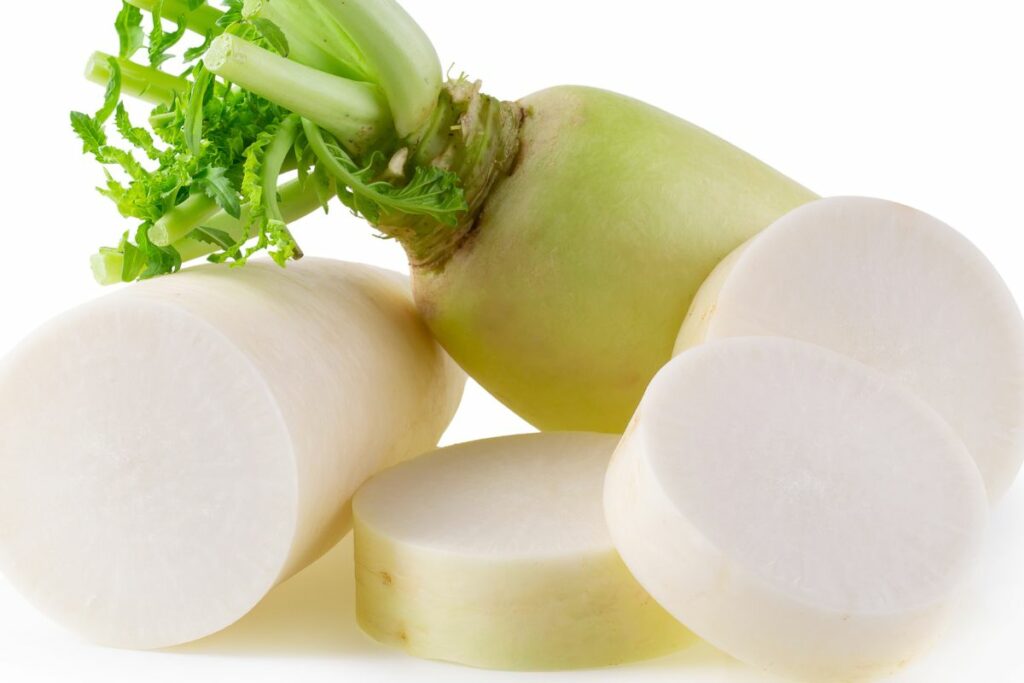Korean radish, also known as mu or moo, is a staple ingredient in Korean cuisine. It is a large, white, and crunchy root vegetable that is often used in pickling, soups, stews, and salads. However, finding Korean radish in some parts of the world can be challenging. That’s where Korean radish substitutes come in handy.
There are several Korean radish substitutes that can be used in recipes that call for this root vegetable. One of the most popular substitutes is daikon radish, which has a similar texture and flavor to Korean radish. Other substitutes include ponytail radish, Indian radish, turnip, winter radish, Geogeol radish, young summer radish, cabbage heart, and white carrot. Each substitute has its own unique flavor and texture, so it’s important to choose the right one for the recipe.

Contents
- 1 Understanding Korean Radish
- 2 Taste and Texture of Korean Radish
- 3 Common Uses in Korean Cuisine
- 4 Top Korean Radish Substitutes
- 5 Choosing the Right Substitute
- 6 Storing and Preparing Radish Substitutes
- 7 Health Benefits of Radish and Its Substitutes
- 8 Incorporating Radish Substitutes into Recipes
- 9 Other Considerations When Choosing a Substitute
Understanding Korean Radish
Korean radish, also known as mu, is a root vegetable that belongs to the brassica family. It is a member of the same family as other popular vegetables like broccoli, cauliflower, and cabbage. The scientific name of Korean radish is Raphanus sativus var. longipinnatus.
Korean radish is an essential ingredient in Korean cuisine, particularly in savory Korean side dishes known as banchan. It is a versatile vegetable that can be used both raw and cooked. It has a mild flavor and a crunchy texture that makes it an excellent addition to salads and pickled dishes.
Korean radish is an oval-shaped vegetable that can grow up to 12 inches in length and 4 inches in diameter. It has a white flesh and a light green skin. The skin of the Korean radish is thin and can be easily peeled off using a vegetable peeler.
Korean radish is a nutrient-dense vegetable that is low in calories and high in vitamins and minerals. It is an excellent source of vitamin C, potassium, and fiber. It also contains antioxidants that help to protect the body against damage from free radicals.
In Korean cuisine, Korean radish is often used to make kimchi, a spicy fermented vegetable dish that is a staple in Korean cuisine. It is also used to make soups, stews, and other savory dishes. Korean radish can be found in most Asian grocery stores and specialty food markets.
Taste and Texture of Korean Radish
Korean radish, also known as mu or moo, is a root vegetable that is widely used in Korean cuisine. It has a sweet, mild flavor and a crunchy texture that makes it a popular ingredient in salads, pickles, stews, and soups.
The taste of Korean radish is often described as slightly sweet and mild, with a subtle earthy flavor. It is not as pungent as other types of radishes, making it a great choice for those who prefer milder flavors. The sweetness of Korean radish comes from its natural sugars, which are more concentrated than in other radish varieties.
In terms of texture, Korean radish is known for its crisp, crunchy texture. When cooked, it becomes tender but still retains some of its crunchiness. This makes it a versatile ingredient that can be used in both raw and cooked dishes.
Korean radish is often used in kimchi, a traditional Korean dish made with fermented vegetables. Its mild flavor and crunchy texture make it a great choice for kimchi, as it adds a refreshing crunch and balances out the spiciness of the dish.
Overall, Korean radish is a delicious and versatile ingredient that can add flavor and texture to a wide range of dishes. Its sweet, mild flavor and crunchy texture make it a popular choice in Korean cuisine and a great substitute for other types of radishes in recipes.
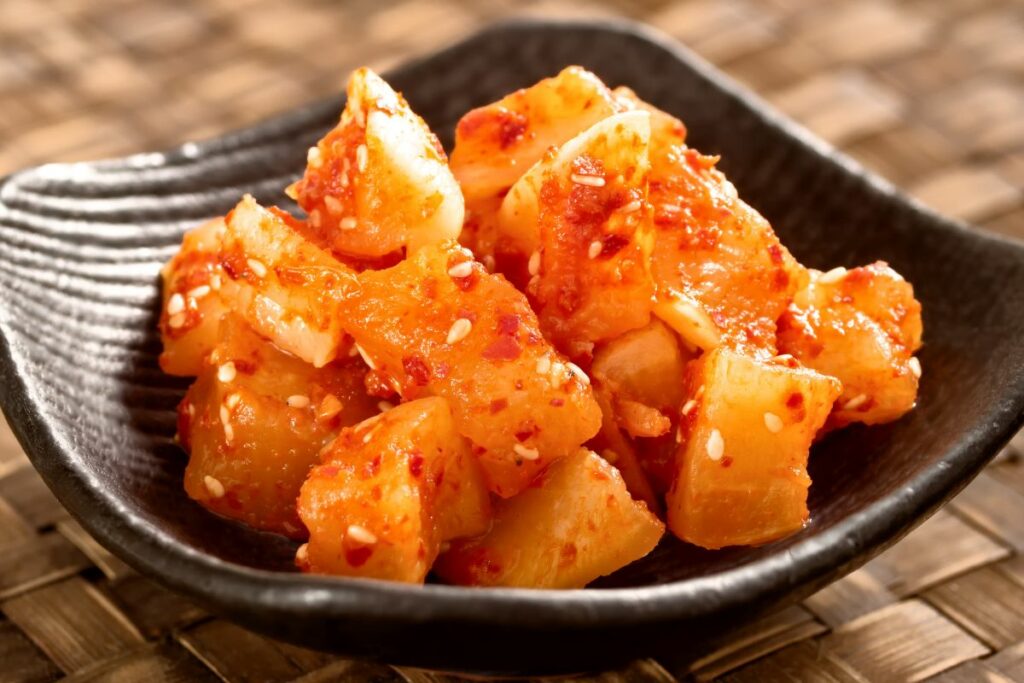
Common Uses in Korean Cuisine
Korean radish is a staple ingredient in Korean cuisine and is used in a variety of dishes. Here are some common uses of Korean radish in Korean cuisine:
Kimchi
Kimchi is a traditional Korean side dish made with fermented vegetables and spices. Korean radish is a key ingredient in making kimchi. It is sliced into thin pieces and mixed with other vegetables such as cabbage, scallions, and garlic, along with spicy seasonings. Daikon radish can be used as a substitute for Korean radish in making kimchi.
Soups and Stews
Korean radish is commonly used in soups and stews. It adds a sweet and slightly spicy flavor to the dish. One popular soup made with Korean radish is moo radish soup, which is a beef broth-based soup with sliced radish and beef. Another popular stew is kimchi jjigae, a spicy stew made with kimchi, pork, tofu, and Korean radish.
Salads
Korean radish is also used in salads. It can be sliced thinly and mixed with other vegetables to make a refreshing side dish. One popular salad is mu namul, which is a Korean radish salad made with thinly sliced radish, scallions, and a soy sauce dressing.
Pickled Radish
Pickled radish is a popular snack in Korea and is often served as a side dish with meals. Kkakdugi is a type of pickled Korean radish that is made with diced radish, scallions, garlic, and spicy seasonings. Dongchimi is another type of pickled Korean radish that is made with sliced radish, pear, and ginger.
Other Dishes
Korean radish is also used in other dishes such as kimbap, a Korean-style sushi roll, where it is used as a filling. It can also be stir-fried with other vegetables and meat to make a flavorful side dish.
Overall, Korean radish is a versatile ingredient in Korean cuisine that adds a unique flavor and texture to dishes.
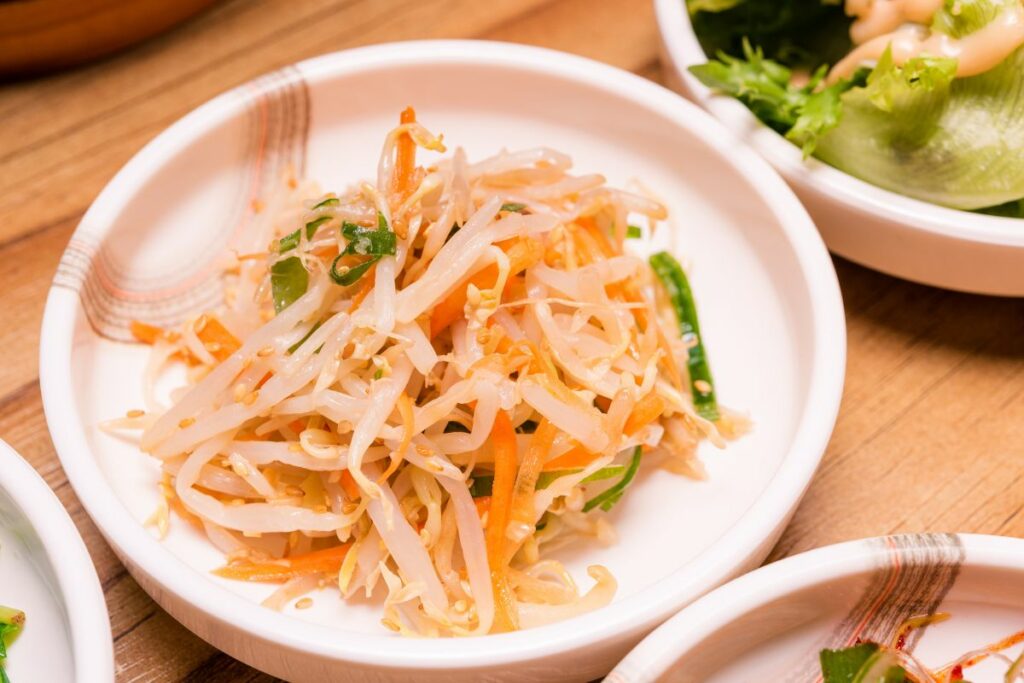
Top Korean Radish Substitutes
If you are looking for a Korean radish substitute, there are several options available that can add a similar crunch and flavor to your dishes. Here are some of the best Korean radish substitutes:
Daikon Radish
Daikon radish is a staple in Asian cuisine and is often used as a substitute for Korean radish. It has a similar texture and flavor, although it is milder and less sweet. Daikon radish is also a good source of vitamin C and fiber.
White Turnip
White turnip is another good substitute for Korean radish. It has a similar texture and flavor, although it is milder and less sweet. White turnip is also a good source of vitamin C and fiber.
Jicama
Jicama is a root vegetable that is commonly used in Mexican cuisine. It has a crunchy texture and a slightly sweet flavor, making it a good substitute for Korean radish. Jicama is also a good source of vitamin C and fiber.
Red Radish
Red radish is a small, round root vegetable that is often used in salads and sandwiches. It has a crunchy texture and a slightly spicy flavor, making it a good substitute for Korean radish. Red radish is also a good source of vitamin C and fiber.
Napa Cabbage
Napa cabbage is a type of Chinese cabbage that is often used in Korean cuisine. It has a crunchy texture and a slightly sweet flavor, making it a good substitute for Korean radish. Napa cabbage is also a good source of vitamin C and fiber.

Carrots
Carrots are a root vegetable that are often used in salads and stir-fries. They have a crunchy texture and a slightly sweet flavor, making them a good substitute for Korean radish. Carrots are also a good source of vitamin A and fiber.
Watermelon Radish
Watermelon radish is a type of radish that has a sweet, mild flavor and a crisp texture. It is a good substitute for Korean radish in salads and pickled dishes.
Horseradish Root
Horseradish root has a pungent, spicy flavor and a crunchy texture, making it a good substitute for Korean radish in spicy dishes. It is also a good source of vitamin C and fiber.
Parsnip
Parsnip is a root vegetable that has a sweet, nutty flavor and a tender texture. It is a good substitute for Korean radish in soups and stews.
Kohlrabi
Kohlrabi is a type of cabbage that has a mild, sweet flavor and a crunchy texture. It is a good substitute for Korean radish in salads and pickled dishes.
Green Papaya
Green papaya is a type of fruit that is often used in Southeast Asian cuisine. It has a crunchy texture and a mild flavor, making it a good substitute for Korean radish in salads and pickled dishes.
Celery
Celery has a crunchy texture and a slightly sweet, nutty flavor, making it a good substitute for Korean radish in salads and stir-fries. It is also a good source of vitamin K and fiber.
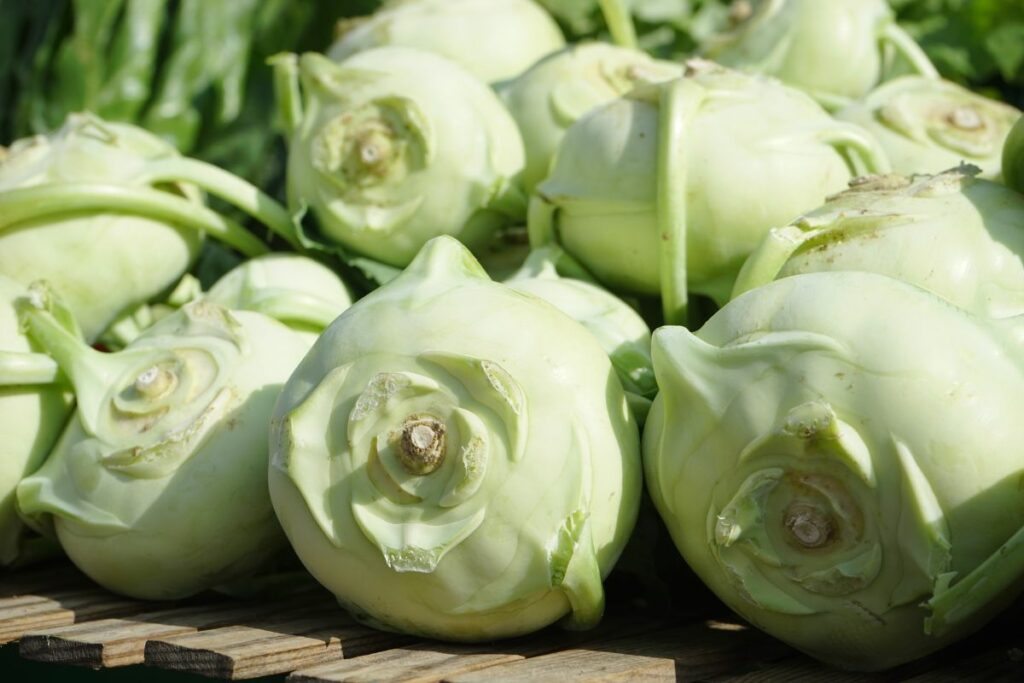
Indian Radish
Indian radish is a type of radish that has a similar texture and flavor to Korean radish. It is often used in Indian cuisine and is a good substitute for Korean radish in pickled dishes and soups.
Choosing the Right Substitute
When it comes to substituting Korean radish, there are several factors to consider. The right substitute will depend on the recipe, personal taste, and availability of ingredients. Here are some tips for choosing the right substitute:
Flavor
Korean radish has a mild, slightly sweet flavor. When choosing a substitute, look for an alternative that has a similar flavor profile. Daikon radish is a popular substitute because it has a mild, slightly sweet taste that is similar to Korean radish. Other alternatives like white turnips and watermelon radish can also be used as they have a slightly sweet and mild taste.
Versatility
Some substitutes are more versatile than others. For example, daikon radish can be used in a variety of Korean dishes, including kimchi, soups, and stews. White turnips and watermelon radish are also versatile and can be used in a variety of dishes. When choosing a substitute, consider how versatile it is and whether it can be used in multiple recipes.
Availability
Availability is another important factor to consider when choosing a substitute. Korean radish may not be readily available in all areas, so it’s important to choose a substitute that is easy to find. Daikon radish is widely available in most grocery stores and Asian markets, making it a popular substitute. Other alternatives like white turnips and watermelon radish may be harder to find, but can still be found in specialty food stores.
Cooking Method
The cooking method can also affect which substitute is best. For example, if the recipe calls for Korean radish to be pickled, then daikon radish or white turnips would be a good substitute as they both hold up well when pickled. If the recipe calls for Korean radish to be roasted, then watermelon radish would be a good substitute as it has a similar texture when roasted.
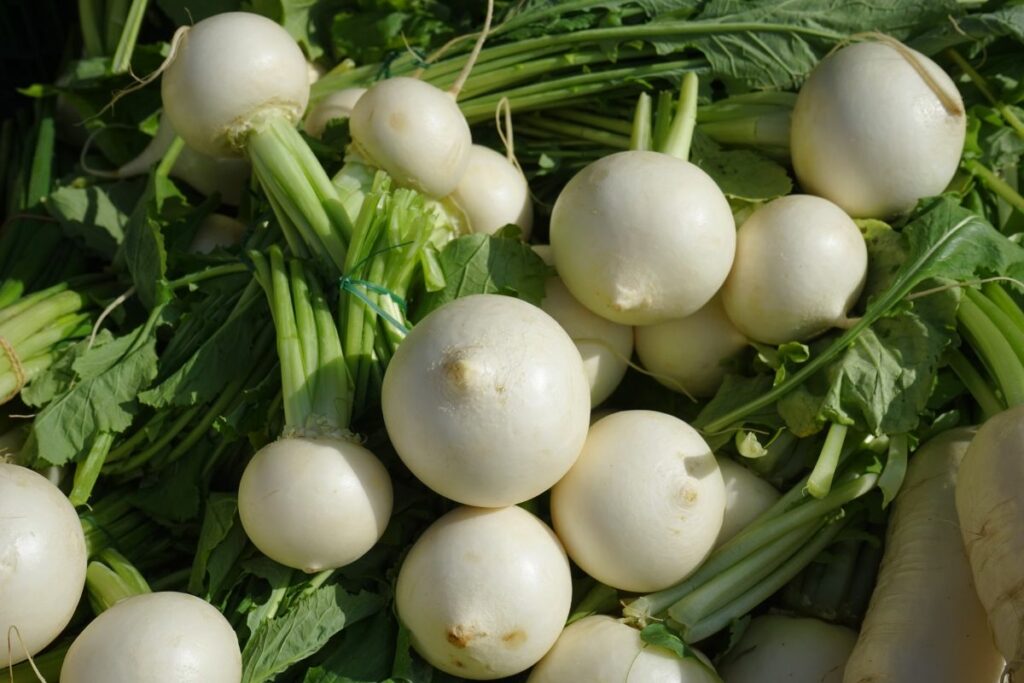
Alternative Options
If none of the above substitutes are available, there are other alternatives that can be used. Cabbage hearts, red radishes, horseradish root, and white carrot are all good substitutes for Korean radish in certain recipes. However, it’s important to note that these alternatives may not have the exact same flavor profile as Korean radish.
Overall, choosing the right substitute for Korean radish will depend on several factors. By considering the flavor, versatility, availability, cooking method, and alternative options, it’s possible to find a substitute that works well in any recipe.
Storing and Preparing Radish Substitutes
When it comes to storing and preparing radish substitutes, there are a few things to keep in mind. Here are some tips:
Storing
- Most radish substitutes can be stored in the refrigerator for up to a week.
- To keep them fresh longer, wrap them in a damp paper towel and store them in a plastic bag in the refrigerator.
- Turnips, daikon radish, and red radish can also be stored in a cool, dark place for up to a week.
Slicing
- When slicing radish substitutes, it’s important to use a sharp knife to ensure even slices.
- For a more decorative look, use a mandoline to slice radish substitutes thinly.
- Sliced radish substitutes can be used in salads, sandwiches, and as a garnish for soups and stews.
Pickled
- Radish substitutes can be pickled in the same way as Korean radish.
- To make a basic pickling liquid, combine equal parts water and vinegar with sugar and salt to taste.
- Sliced radish substitutes can be pickled in this liquid for a tangy, crunchy snack or condiment.
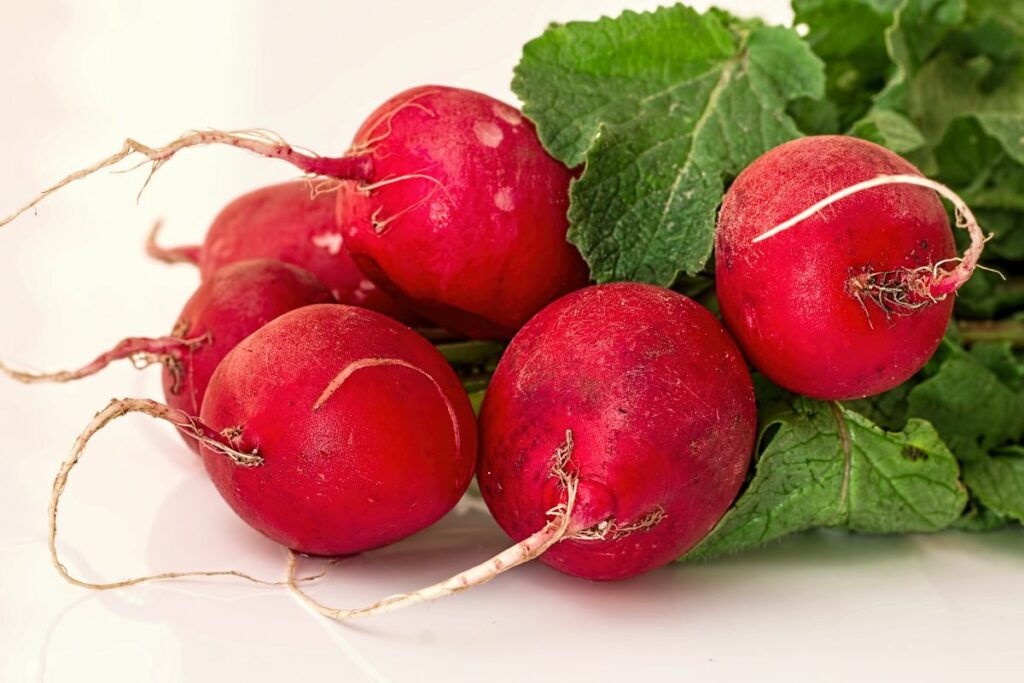
Boiled and Steamed
- Turnips and daikon radish can be boiled or steamed and used in soups, stews, and stir-fries.
- To boil, simply add sliced turnips or daikon radish to a pot of boiling water and cook until tender.
- To steam, place sliced turnips or daikon radish in a steamer basket and steam for 5-10 minutes, until tender.
Overall, radish substitutes are versatile and easy to prepare. Whether pickled, boiled, or sliced, they can add a unique flavor and texture to a variety of dishes.
Health Benefits of Radish and Its Substitutes
Radish and its substitutes offer a variety of health benefits. They are low in calories and high in fiber, making them a great addition to any diet. Additionally, they are packed with vitamins and minerals that are essential to overall health.
One of the main benefits of radishes and their substitutes is their high vitamin C content. Vitamin C is an important antioxidant that helps to protect cells from damage caused by free radicals. It also plays a key role in immune function and collagen production.
Fiber is another important nutrient found in radishes and their substitutes. Fiber helps to promote healthy digestion and gut health by adding bulk to stool and preventing constipation. It can also help to regulate blood sugar levels and lower cholesterol.
Potassium is another nutrient found in radishes and their substitutes. Potassium is important for maintaining healthy blood pressure levels and promoting heart health. It also plays a role in muscle and nerve function.
Magnesium is another mineral found in radishes and their substitutes. Magnesium is important for bone health and helps to regulate muscle and nerve function. It is also involved in energy production and can help to reduce inflammation.
Calcium is also found in radishes and their substitutes. Calcium is important for bone health and can also help to promote healthy teeth. It is also involved in muscle and nerve function.
Finally, probiotics are also found in some radish substitutes, such as kimchi. Probiotics are beneficial bacteria that help to promote gut health and boost immune function. They can also help to reduce inflammation and improve digestion.
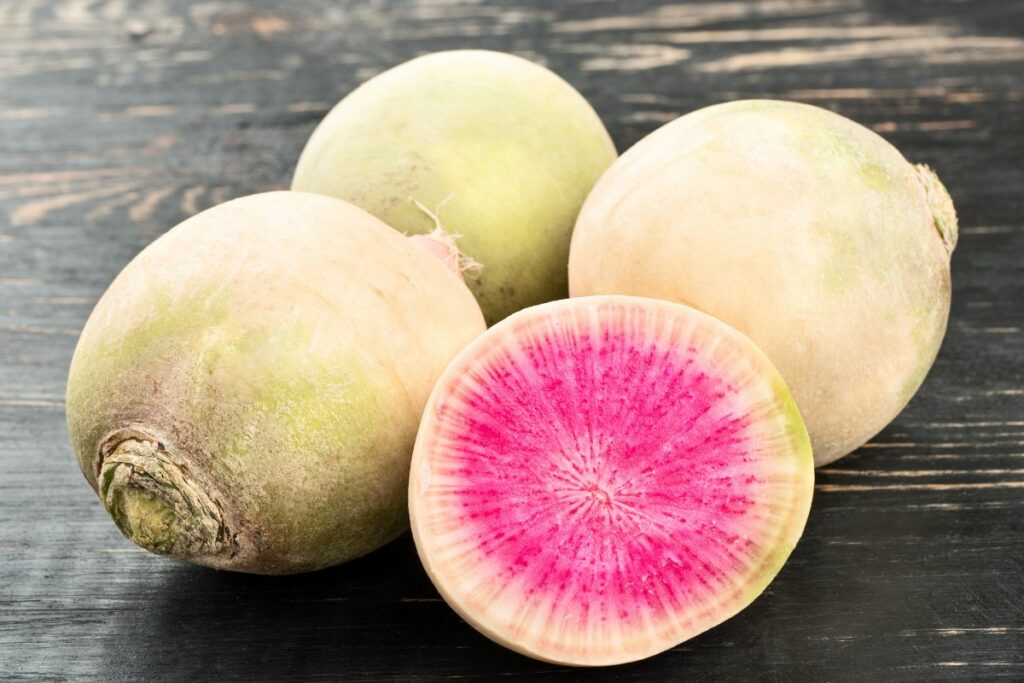
Incorporating Radish Substitutes into Recipes
Substituting Korean radish with other vegetables can add a unique flavor and texture to your recipes. Here are some tips on how to incorporate radish substitutes into your dishes:
Recipes
For recipes that call for Korean radish, there are several substitutes that can be used. Daikon radish, also known as white radish, is a popular substitute for Korean radish. It has a similar texture and flavor and can be used in recipes like kimchi, stir-fries, and radish salad. Other substitutes include watermelon radish, black radish, and ponytail radish.
Stir-Fries
In stir-fries, radish substitutes can add a crunchy texture and a hint of sweetness. Daikon radish can be sliced thinly and added to stir-fries with other vegetables like carrots, bell peppers, and onions. Watermelon radish can also be used in stir-fries and will add a pop of color to the dish.
Radish Salad
Radish salad is a refreshing side dish that can be made with a variety of radish substitutes. Black radish can be grated and mixed with other vegetables like carrots and cabbage to create a slaw-like salad. Daikon radish can also be used in a radish salad and should be sliced thinly for best results.
Slaw
Radish substitutes can also be used in slaw recipes. Watermelon radish can be grated and mixed with cabbage, carrots, and other vegetables to create a colorful and flavorful slaw. Black radish can also be used in slaw recipes and will add a unique flavor and texture to the dish.
Fish Sauce, Garlic, and Ginger
When using radish substitutes in recipes, it is important to consider the other ingredients in the dish. Fish sauce, garlic, and ginger are common ingredients in Korean cuisine and can be used to enhance the flavor of radish substitutes. Adding a splash of fish sauce to a stir-fry or a pinch of garlic and ginger to a radish salad can take the dish to the next level.
Overall, incorporating radish substitutes into your recipes can add a unique flavor and texture to your dishes. Experiment with different substitutes and find the ones that work best for your taste preferences.

Other Considerations When Choosing a Substitute
When choosing a substitute for Korean radish, there are several factors to consider. The first is the flavor profile. Korean radishes have a slightly sweet and crisp taste that is unique to them. Therefore, it is essential to choose a substitute with a similar taste profile.
One option is cabbage hearts. They have a mild and slightly sweet flavor that is similar to Korean radish. They also have a crisp texture that makes them a good substitute for salads and pickled vegetables. White carrots are another alternative that has a similar flavor and texture to Korean radish. They are also readily available in most grocery stores.
Another factor to consider is the texture of the substitute. Korean radishes have a crisp texture that is essential for some Korean dishes. Therefore, it is crucial to choose a substitute with a similar texture. One option is water chestnuts. They have a crunchy texture that is similar to Korean radish, making them a good substitute for salads and stir-fries.
When choosing a substitute for Korean radish, it is also essential to consider the availability of the substitute. Some substitutes, such as beetroot and Brussels sprouts, are not readily available in most grocery stores. Therefore, it is important to choose a substitute that is readily available in your area.
Lastly, it is essential to consider the cuisine in which you are using the substitute. Some substitutes may work well in Korean dishes but may not be suitable for other Asian cuisines. For example, ponytail radish is a good substitute for Korean radish in Korean dishes, but it may not work well in other Asian cuisines. Greens such as arugula and spinach are versatile substitutes that work well in many dishes.
Overall, when choosing a substitute for Korean radish, it is important to consider the flavor, texture, availability, and cuisine in which it will be used. With these factors in mind, it is possible to find a suitable substitute that will work well in any dish.
